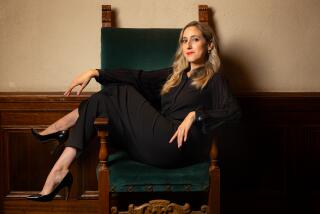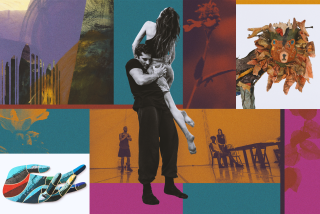Kaleidoscope Ranges From Innovators to Amateurs
- Share via
Formed in the late 1970s to raise the visibility of local artists, the Dance Kaleidoscope series worships an ideal of variety so passionately that attempts to enforce minimal standards of quality control or even organize its programs coherently have proven hopeless. Now in its ninth year under Cal State L.A. sponsorship, it represents the Grand Hotel of annual community events: People come, people go. Nothing ever happens.
This year, Cal State Long Beach joined Loyola Marymount University, the John Anson Ford Amphitheatre and the Luckman Theatre at CSULA as Kaleidoscope presenters, while a half-dozen choreographic elders and worthies have been labeled “Distinguished California Artists” and invited to join those who auditioned for a place on five different programs.
Those programs all carry snappy titles suggesting some sort of curatorship: Over the weekend we saw “On With the Dance” (Friday at the Luckman) “Dance/Next” (Saturday in the same venue) “Up Close and Personal” (Sunday at Loyola Marymount). But don’t be fooled: Kaleidoscope still offers equal opportunity for innovators and hacks, world-class artists and rank amateurs, refugees preserving the performing traditions of antique cultures and opportunists who’ll beat any trend to death if it’ll pass muster with the selection panel.
And it will, it will. As opposed to the Bad Old Days when Kaleidoscope enshrined bland academic rectitude, the first weekend of the 1997 edition offered three manic, sprawling, New Age theater pieces that pretended to reveal our society’s obsession with, respectively, the telephone (Hae Kyung Lee and Dancers), the television (Troika Ranch) and the laundry (Hybrid Physical Theatre), while in fact revealing their creators’ obsession with using objects in place of ideas. Who voted to give such shapeless, workshop-level efforts a major showcase? Why not ask each person chosen as a Distinguished California Artist to curate a Kaleido-evening next year to end the compromises inherent in a committee-based programming process?
Or why not just turn over the whole festival to the artists who created indelible experiences this year and ask them to invite anyone they consider their equals? Who might David Rousseve invite? Certainly the excerpt from his “Whisper of Angels” on the Saturday program confirmed his ability to wed disarming autobiographical text with powerful movement expression. In this case, Rousseve intercut ironic recollections of his demeaning experiences in New York soap operas with painful evocations of a dying man’s desperate need for connection. “Hold me, touch me, stroke me because I’m alone,” he pleaded, while a swirling duet with Kyle Sheldon expressed the realm of intimacy and caring those words invoked.
Victoria Marks, another contemporary dancer-choreographer deeply into text-based autobiographical narrative, made the vision of a tiny girl frozen onstage as Lot’s Wife into an unforgettable Kaleidoscope image without dancing a step in “My First Solo” on the Sunday program. Sitting in a chair and writing a letter to the audience, she told truths about the unique emotional needs of a performing artist that needed no phones, video monitors or washer-dryers for emphasis.
Similarly, Loretta Livingston created a 1997 Kaleido-triumph by focusing on the moments of stillness between compulsive everyday movement and fragments of pop dancing in her intense character solo “The Stray,” a portrait of a woman on the run. Flinging shards of motion against lush Venezuelan ballads, Livingston abandoned her usual nuanced sensitivity for a style emphasizing extreme tension and sudden changes of body language, crowned by passages where she would momentarily lose herself in the music and emerge even more terrified--literally not knowing which way to turn.
The ultimate Kaleidoscope transformation, however, came in “Flit,” which found Hannah Sim and Mark Steger of Osseus Labyrint looking like nothing human: naked, shaven, walking while bent double, on hands and feet, with heads nodding like dead weight as they moved. Think of Alwin Nikolais’ classic “Mantis” infused with butoh body-torture and you can glimpse the combination of imagination and rigor on display in this amazing duet.
Among more familiar repertory, the Lula Washington Dance Theatre definitely put its best feet forward on Sunday with a sharply executed revival of Donald McKayle’s 25-year-old suite “Songs of the Disinherited,” still pertinent in its view of struggle and solidarity. Providing what may be a last look at Bella Lewitzky’s body of work, Lori McWilliams and John Pennington gave their 11-year-old “Facets” duet great freshness and resonance on Friday.
Starting with an astonishing gymnastic solo by Jeremy Jacobs, “Te^te au Carre” featured spectacular manipulations of a huge metal cage by members of Diavolo Dance Theater. However, you could argue that the work’s original meanings are in danger of disappearing altogether as the company increasingly transforms itself into something that might be called Cirque de L.A.
Of the nine remaining artists and companies appearing in the opening weekend, world-dance specialists created a kaleidoscope all their own--with the Sona-Sane West African Dancers emphasizing irresistible rhythmic vitality in “Domba;” Sophiline Shapiro of Danse Celeste giving her “Robam Chhouy Chhay” solo the supernatural serenity and sculptural purity exalted in ancient Cambodian classicism; Amrapali Ambegoakar setting up a high-speed shimmer of footwork while exuding perfect calm in “Tarana,” a solo from India in the traditional Kathak repertory.
*
Dance Kaleidoscope continues on Thursday at 8 p.m. in the Knoebel Dance Theatre at Cal State Long Beach, 6200 Atherton St. Tickets: $12-$18. (562) 985-7000. The two final performances take place on Saturday in the John Anson Ford Amphitheatre, across from Hollywood Bowl in Cahuenga Pass: a one-hour family program at 10 a.m. ($7) and a world-dance sampler at 8 p.m. ($12-$18). (213) 658-4077.
More to Read
The biggest entertainment stories
Get our big stories about Hollywood, film, television, music, arts, culture and more right in your inbox as soon as they publish.
You may occasionally receive promotional content from the Los Angeles Times.










